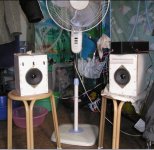Hey guys,
So I just hooked up my Snell SUB1800 to my new Behringer EP2500 and its sounding a little funny. If I turn up the volume past halfway on the amp the clip light goes off, and I'm getting A LOT of noise from the ports. There is so much air moving so fast through the port that is kinda whistling or making the "chuffing" noise. Any tips on how to fix this? Will making the ports longer help at all? Any help will be much appreciated.
Also, Im using a Paradigm X-20 crossover, and even at the lowest cutoff of 35Hz im getting sounds other than just bass coming through when its at very low volumes. Could this be because I'm using low level inputs instead of speaker level inputs?
Thanks for all the help guys.
So I just hooked up my Snell SUB1800 to my new Behringer EP2500 and its sounding a little funny. If I turn up the volume past halfway on the amp the clip light goes off, and I'm getting A LOT of noise from the ports. There is so much air moving so fast through the port that is kinda whistling or making the "chuffing" noise. Any tips on how to fix this? Will making the ports longer help at all? Any help will be much appreciated.
Also, Im using a Paradigm X-20 crossover, and even at the lowest cutoff of 35Hz im getting sounds other than just bass coming through when its at very low volumes. Could this be because I'm using low level inputs instead of speaker level inputs?
Thanks for all the help guys.
1. Make sure the port is flared/radiused
2. Increase the port cross-sectional area
Search either this group or the loudspeaker group for "port" and you will find a thread of someone who did a lot of port experiments and came up with a ratio for the port opening to the port diameter, also, an excel spreadsheet for the air velocity inside the port.
I found my copy of the link:
http://www.users.bigpond.com/bcolliso/port-flares.htm
2. Increase the port cross-sectional area
Search either this group or the loudspeaker group for "port" and you will find a thread of someone who did a lot of port experiments and came up with a ratio for the port opening to the port diameter, also, an excel spreadsheet for the air velocity inside the port.
I found my copy of the link:
http://www.users.bigpond.com/bcolliso/port-flares.htm
You need more cross-sectional area and/or lower tuning.
You will experience some bleed of sound if you put your ear right to the sub. the only way to avoid it is to use a steeper crossover. Unless it's a noticeable problem in actual use it's nothing to worry about. It's nothing to do with using high- or low-level input.
The clip light coming on with just half dial setting is nothing to worry about either. The dial is justy the input sensitivity so a louder source will not need as much on the dial to sound the same as a quieter source. It's perfectly possible to drive an amp to full output with half dial or less if the source is strong enough.
You will experience some bleed of sound if you put your ear right to the sub. the only way to avoid it is to use a steeper crossover. Unless it's a noticeable problem in actual use it's nothing to worry about. It's nothing to do with using high- or low-level input.
The clip light coming on with just half dial setting is nothing to worry about either. The dial is justy the input sensitivity so a louder source will not need as much on the dial to sound the same as a quieter source. It's perfectly possible to drive an amp to full output with half dial or less if the source is strong enough.
- or -69stingray said:1. Make sure the port is flared/radiused
2. Increase the port cross-sectional area
3. Use a port shaped like a rocket motor.
http://www.haliaetus.com/va/haliaetus.html (go to 'technology'). Unfortunately the AES 116 paper "Sound source design in the very low frequency domain." is no longer attached to the website. But it made interesting reading - and the gist of it is shown on the website. Basically, you can get a bigger volume of air flowing through a smaller port than via conventional flaring or using a constant radius port.
- Status
- Not open for further replies.
- Home
- Loudspeakers
- Subwoofers
- Port noise
